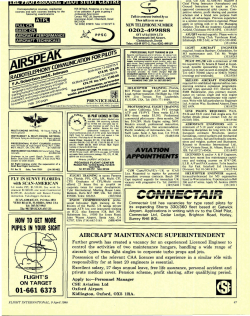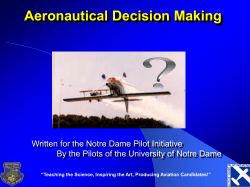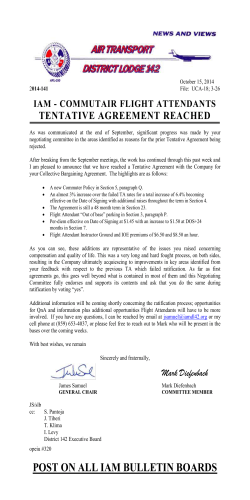
Practice makes a proficient
Photo by James Williams Practice makes Proficient I By Susan Parson n his 2008 book, Outliers: The Story of Success, author Malcolm Gladwell ponders the characteristics that put some people head and shoulders above the rest of the pack in their chosen field. Threaded throughout are references to what Gladwell calls the 10,000-Hour Rule. Based on a study by Florida State University professor Anders Ericsson, this “rule” holds that success in a given activity is based not so much on talent, but rather on practice…lots of practice. If you care to do the math, 10,000 hours of practice equates to something along the lines of 20 hours of practice per week for 10 years. September/October 2010 FAA Safety Briefing 7 Photo by James Williams Wow. As much as we might like to do so, most general aviation pilots have neither the time nor the resources to devote 20 hours a week to flying. On the contrary, many of us spend most of our time at jobs that let us earn money for the level of flying we can afford to do after paying for such non-discretionary trifles as food and shelter. So, what is a conscientious pilot to do? Make It Count Though somewhat counter to the research giving rise to the 10,000-Hour Rule, the notion that quality counts more than quantity is ingrained in the collective wisdom. There’s a good reason for that: Quality does matter, and quantity alone does not necessarily result in expertise. Let’s take an aviation example. Generally, pilots need a total of 1,500 hours to qualify for the airline transport pilot (ATP) certificate, and there is a tendency to assume that a pilot with 1,500 hours of flying experience must be a pretty good stick. Yet, what if that pilot accumulated 1,500 hours of visual flight rules (VFR) flying within 35-nautical miles of home base? That pilot might qualify as an expert on VFR operations in that one small area, but you can probably agree that this example illustrates the folly 8 FAA Safety Briefing September/October 2010 of assuming that a specific quantity of flying time translates automatically to the quality of experience you should expect from a pilot who has attained the “Ph.D.” of aviation. The same logic applies to other certificates and ratings. That’s why the regulations governing pilot certification do not simply specify a total number of hours. Rather, the regulations address quality by dividing the total minimum hours required for a given certificate or rating into various categories of aeronautical experience. These typically include cross-country time (with a specific definition of what constitutes cross-country flight), instrument-flying time, and dual-instruction time. When you are working toward a pilot certificate or rating, especially with a limited budget, you quickly learn to make every hour of your flying time and money count toward your goal. There is no reason you can’t use the same make-it-all-count strategy when you are flying “only” for proficiency. A conscientious pilot should always be aiming for greater proficiency, which means assuming a mindset of making every hour count—in other words, imbuing the quantity of all your flying, however limited, with quality. The Civil Air Patrol (CAP) also publishes a list of its approved pilot-proficiency profiles. You don’t have to be a CAP member to print the list and use it as a guide to developing your personal proficiency plan. The second part of your ongoing aeronautical health plan is to establish goals you want to achieve as a pilot. The obvious achievement goals are to add a certificate, rating, or endorsement for a new operating privilege, e.g., tailwheel, to your qualifications. Consider, too, the possibility of specialty training, such as a focused upset/ spin recovery course or a few sessions of aerobatic training. You might also set a goal of gaining enough proficiency to lower your personal minimums in one or more of the listed categories. There is another important item to plan, which is the quantity—the frequency—of your flying. We all get busy, and it is easy to let proficiency flying slide in favor of more pressing things. Having a specific numerical goal of flying “x” number of hours per month can help you stay on track. Make It Interesting Make It Planned One of the most effective ways to get the most out of your flying time is to make a personal piloting proficiency plan. Just like a flight plan, your personal proficiency plan should be based on a “destination” or goal. When conducting a flight review, I address proficiency planning by asking the pilot two questions: • W hat aspect of your flying do you most need to improve? • W hat do you most want to achieve through your flying? The answers guide not only the flight review, but also the development of an ongoing “aeronautical health plan” for pilot proficiency and skill development. See the links at the end of this article for examples on how to approach this process. For the first part of your ongoing aeronautical health plan—improvement—the Personal Proficiency Practice Plan in FAA’s Conducting an Effective Flight Review lists tasks and maneuvers for basic VFR proficiency. Consider devoting at least one flight every 4-6 weeks to flying through this list. If you feel too rusty to try them all on your own, hire a qualified flight instructor to go along for the first flight or two. If you’re bored with the basics, branch out! Learning new skills and stretching your wings is an important element of proficiency flying. Also, keeping it interesting and challenging can provide some of the motivation to keep it up once you have your aeronautical health and improvement plan established. We have already mentioned new certificates, ratings, endorsements, and specialty training as ideas for adding the spice of variety to your proficiency flying. You do not have to be earning the certificate to tackle some of the high-performance maneuvers in the commercial-pilot syllabus. Mastering these maneuvers will enhance your proficiency in precision-aircraft control, energy management, situational awareness, and much more. Still another idea for making your proficiency flying more interesting is to fly outside the range of your usual practice area. To encourage this kind of flying (as well as visits to its public-use airports), the Virginia Department of Aviation established the Virginia Aviation Ambassadors Program. There are several levels of achievement, but pilots who obtain a “passport stamp” from all 66 of the state’s publicuse airports and fulfill a few other requirements, e.g., visit aviation museums, attend a safety seminar, and attend the state’s annual Festival of Flight, get the top prize along with the satisfaction of being a “gold”-level Virginia Aviation Ambassador. Reaching this level was part of my personal-proficiency plan for this year. September/October 2010 FAA Safety Briefing 9 Photo by H. Dean Chambelain Several states have programs similar to Virginia’s, but even if your state doesn’t have a formal program, there’s no reason you can’t include a visit-all-the-state-airports goal in your aeronauticalachievement plan. Make It Better Practice makes a proficient pilot, but only if you pay attention, learn from your mistakes, and resolve to do better every time you fly. Perfection may seem to be an unattainable or unrealistic goal, but aiming to be the best will get you a lot farther up the proficiency ladder than settling for “good enough.” Getting better with every flight requires you to understand where you fell short on the last one, why it happened, and how you can fix it next time. Persistent (or mysterious) mistakes may need For More Information Conducting an Effective Flight Review – Appendix 8, Personal Proficiency Practice Plan www.faa.gov/pilots/training/media/flight_review.pdf Civil Air Patrol Approved Proficiency Flight Profiles (PROFILE #7) www.capmembers.com/media/cms/CAPR_601_ Profiles_2A62D0A690C1A.pdf FAA Aviation Instructor’s Handbook (FAA-H-8083-9A) www.faa.gov/library/manuals/aviation/aviation_instructors_ handbook/media/FAA-H-8083-9A.pdf 10 FAA Safety Briefing September/October 2010 professional intervention in the form of a qualified flight instructor, but you can—and you should— develop your ability to self diagnose the deficiencies that undermine your proficiency. For tips on how to build this important skill, check out chapter 5 (Assessment) in the FAA Aviation Instructor’s Handbook (FAA-H-80839A). One technique for effective post-flight self assessment includes four distinct steps: • R eplay the flight in your mind, taking note of what you did well and what you need to improve. • R econstruct the maneuvers where you made mistakes, considering what you could have done differently. • R eflect on the most important lesson(s) you learned from this specific flight. • R edirect those lessons to your planning for the next flight. You may not be able to accumulate 10,000 hours, but a quality-focused approach to every hour you do have in the cockpit can go a long way to making you a better and more proficient pilot. Susan Parson ([email protected]) is a Special Assistant in the FAA’s Flight Standards Service. She is an active general aviation pilot and flight instructor.
© Copyright 2025










